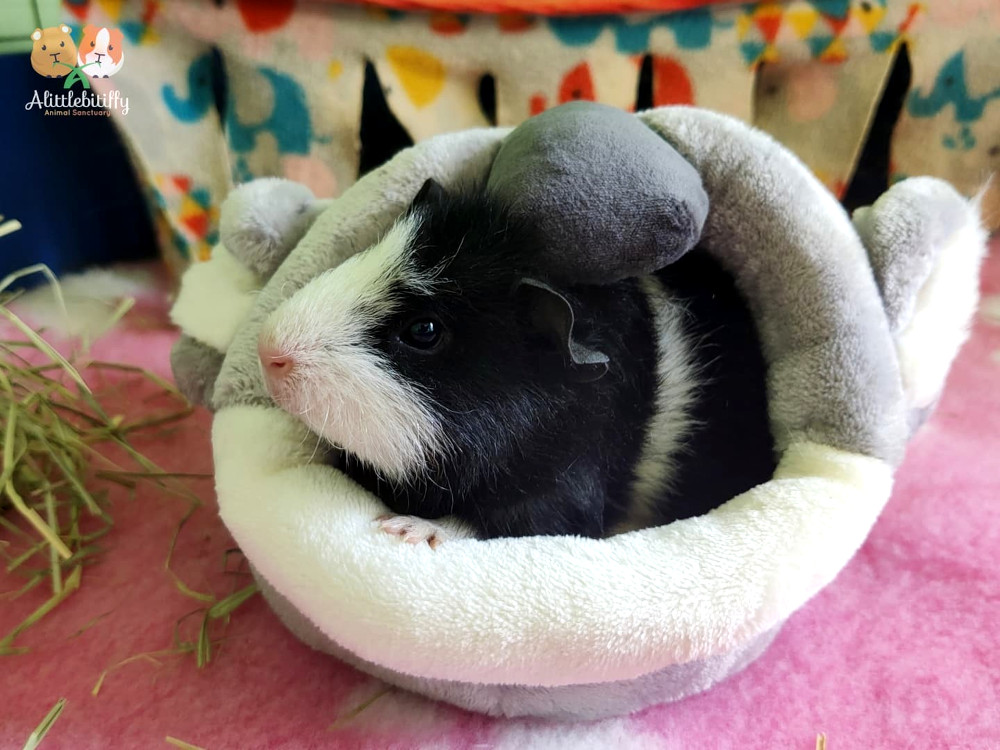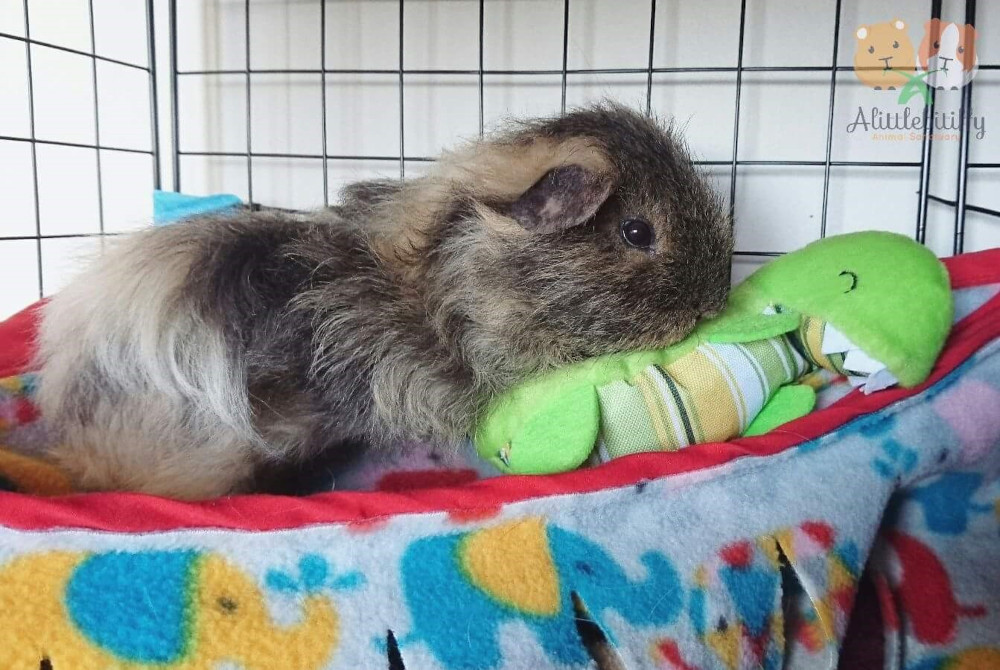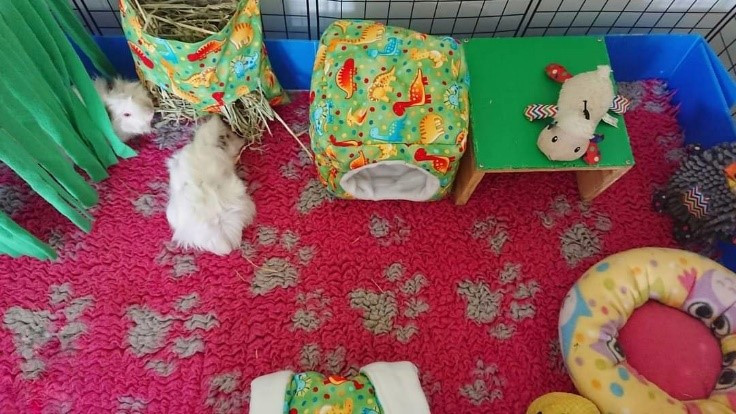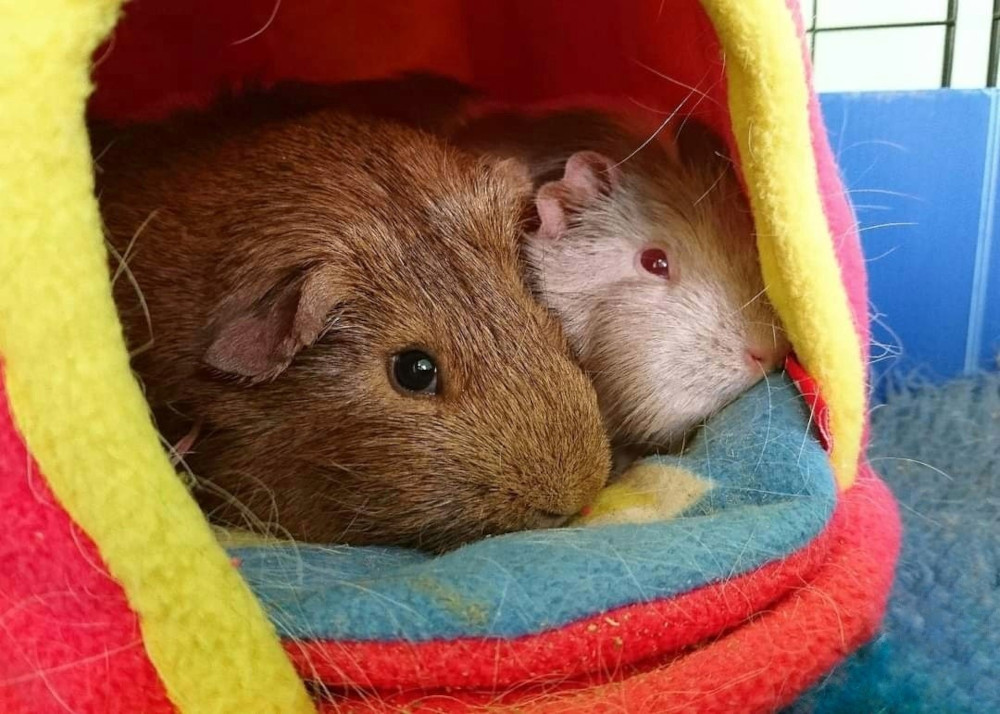In order to answer this question, it’s first necessary to consider how guinea pigs behave in the wild!
Behaviour of wild guinea pigs
The wild cavy/guinea pig (Cavia aperea) is a medium-size, herbivorous, neotropical rodent found in low numbers in humid grassland habitats of south-eastern South America, and in the highlands of the Andes mountain range. They prefer areas of thick ground cover but can be found in disturbed habitats as well. They do not occur in tropical rain forests. Despite their popularity as pets, there is surprisingly little known about wild guinea pig behaviour.
The main pressures on wild guinea pigs are predation and habitat availability. Dense, high vegetation is used as shelter from predators. Wild cavies are not diggers and do not have burrows to protect themselves from predator attacks but hide and move through tunnels made in thick vegetation. Within the dense vegetation, they do use the same sleeping or resting sites but constantly alter their resting places. They communicate through auditory signals (a series of high-pitched squeals and screams) and scent marks. Males scent mark using a gland above their anus. Although they are unlikely to scent mark specific territories, they often mark their mates and defend them against rival males.
Foraging occurs in the morning and evening and rarely during the day, reflecting that wild cavies are most active during periods of low light, and shelter from predators during the day and night. Activity in areas of short vegetation is limited to short feeding periods, which are often interrupted by adopting alert postures or by fast dashes into thick vegetation.
This behaviour is an adaptation to high predation pressure, as is the adoption of small group sizes (one male and one or two females) occupying stable home ranges that overlap only slightly with home ranges of adjacent groups.
When this activity is analysed, it can be seen that:
- Guinea pigs have evolved to be crepuscular i.e., they are most active at dusk and dawn.
- They live in small groups in defined territories.
- They eat in short bursts, ready to flee from a perceived predator.
- They communicate through scent marking and through squeaks and whistles.
- They require shelter from predation to feel secure.
- The high incompatibility between males makes it impossible to keep several adult males together in the presence of females.
What happens if we don’t provide appropriate enrichment for guinea pigs?
With their food in the same place at the same time each day, guinea pigs only need to spend 10%-20% of their time locating and eating their food. This leaves 80% of the day to be filled with other activities. When a guinea pig is housed by on their own, with limited social opportunities available, it is no wonder that some captive guinea pigs develop behavioural problems such as over-grooming, stereotypic behaviours, and mental dullness.
Environmental enrichment can be defined as “the stimulation of the brain by its physical and social surroundings in an attempt to reduce or overcome problems caused by containment”. Its goals are to alter the guinea pig’s captive behaviour so that it is similar to the normal behaviour of guinea pigs in the wild, as described above.
Environmental enrichment therefore aims to provide activities for your guinea pig to engage in that ‘fill’ the currently empty 80% of the day and stimulate the guinea pig’s brain while doing so.
It is generally considered that animals who are behaviourally well-adapted to their environment display ‘species‐specific behaviour’ as permitted by their social and physical environment and not abnormal behaviours. Guinea pigs who are not adapting well display a range of abnormal behaviours, including:
- Hiding most of the time
- Aggression
- Chewing their cage bars
- Over-grooming
- Changing their feeding or toileting habits
- Drinking too much or playing with the water bottle
- Sitting hunched
- Reluctance to move
- Repeatedly circling their enclosure.
Environmental enrichment should therefore be seen as a means of both preventing and, to an extent, treating these abnormal behaviours.
What does my guinea pig need to help them be happy?
To maintain your guinea pigs’ happiness and sense of safety and security, they need environmental enrichment.
A key concept in environmental enrichment requires that we know ‘species‐typical’ information. It is then important to select enriching strategies that are behaviourally relevant and physically feasible for your guinea pigs. Designing an enrichment plan that is incompatible with their normal behaviour, physical attributes, or existing environment may not only be fruitless but may also cause frustration and potential harm.
There is a tendency to think that environmental enrichment means providing some toys or maybe something to chew on. This is only a small part of the process. An enrichment plan can include some or all of the following:
- Foraging enrichment
- Physical enrichment
- Sensory enrichment
- Social enrichment
- Occupational enrichment
Guinea pigs will also have individual preferences about the kind of enrichment they enjoy. It is important to pay attention to their behaviour and watch which enrichment items they choose to use and enjoy interacting with and use that to further inform your enrichment plan.
Foraging enrichment
Foraging is the act of searching for and finding food. As mentioned earlier, wild guinea pigs can spend up to 80% of their day foraging and feeding, most actively in the morning and the evening. Foraging therefore has great social and behavioural importance but is one of the most severely constrained classes of behaviour in companion guinea pigs; obviously there are potential implications of this common behavioural deficit for guinea pig welfare. Given that we know guinea pigs would normally engage in four basic behaviours on a daily basis – foraging, socialising, grooming and resting – removing the ability to forage (by feeding the same food in the same bowl at the same time) leaves a gaping hole that has to be filled with the other behaviours. A guinea pig that lives alone without other guinea pigs to socialise with may therefore start to over-groom (hair barbering) or sleep excessively. Worse, they may develop stereotypic behaviours such as circling, pacing, biting the wire of their enclosure, etc.
Foraging enrichment therefore seeks to prevent or treat these problems. It requires the guinea pig(s) to chew and sort through, manipulate and/or open objects to get to food. It should reflect the guinea pig’s natural foraging behaviour and can be increased in complexity as the guinea pigs’ skill levels increases. Here’s some ideas you can implement to allow a guinea pig to spend more time foraging for food.
- Scattering the food over the floor of the enclosure, or in a sand pit or kitty litter tray filled with wooden blocks or recycled paper kitty litter.
- Placing the food in small cardboard boxes or paper parcels that have to be chewed open to access the food.
- ‘Feeding racks’ – wire framed boxes fastened to the side of the enclosure at, or just above head height, require some dexterity to access the food contained inside.
- Multiple food dishes around the cage the enclosure, some with food, some without … (they develop resilience as they learn that they are not always successful when looking for food).
- Covering the food dishes with paper or cardboard that your guinea pig must chew through to access the food.
Your guinea pig will have to be taught how to use some of these foraging tools e.g., leaving a cardboard box open till your guinea pig learns there is food in it, and then gradually closing it. You can gradually increase the difficulty of the foraging tools as your guinea pig gets the hang of them and needs new challenges. Weigh your guinea pig daily and watch for unexpected weight loss, which would suggest they may be having difficulty locating food.
Physical enrichment
Physical enrichment ranges from objects placed in the guinea pig’s environment to the environment as a whole (e.g., the space available for your guinea pig to engage in locomotory behaviours such as running and playing).
Guinea pigs are a prey species and must be able to hide in a secure place away from things that scare them. They need constant access to safe hiding places, such as pipes and shelters, where they can go when they want to be alone, hide or escape if they feel afraid. There should be enough places for all your guinea pigs to hide at the same time, and they must be away from the sight and smell of predators such as foxes, cats, dogs, ferrets, and birds of prey.

Guinea pigs like to tunnel, so make sure they have suitable materials that allow tunnelling behaviour, such as pipes and deep piles of hay.
There are some general guidelines to follow when considering safe enrichment items for guinea pigs:
- If the item is constructed of synthetic components, use sturdy and large enough materials to prevent ingestion. Avoid cotton or natural fibres, as these are frequently eaten and can lead to gut obstructions.
- For multiple guinea pigs in a cage, provide multiple enrichment devices to reduce item guarding and aggression.
- For guinea pigs fearful of new items, slowly introduce the enrichment to the guinea pig’s cage (or your guinea pig to the enrichment area).



Sensory enrichment
Sensory enrichment utilises the guinea pig’s senses such as sight, hearing, smell, and touch. Providing ‘a room with a view’, soft background noises (such as audio recordings of rain, forest sounds, etc.,) can improve a guinea pig’s welfare. It must be used with caution, as some guinea pigs may become visibly stressed with loud sounds, certain images, or a lack of security/privacy. Placing a guinea pig’s enclosure in the middle of the family room can certainly provide sensory enrichment but your guinea pig must have the ability to ‘get away from it all’ when the family activities become too much.
Social enrichment
Social enrichment is the social interactions between guinea pigs, and between guinea pigs and people. It can be indirect, where your guinea pig can see or hear other guinea pigs in other enclosures. Direct social enrichment includes cage mate pairing, social rooms with numerous guinea pigs interacting, and allowing contact between enclosures. Done well, it allows the guinea pigs to perform ‘species‐specific’ behaviours (especially when compatible guinea pigs are housed together), but it has the potential to have drawbacks and unwanted behaviours such as cage mate aggression and unexpected pregnancies but there are steps that can be taken to mitigate these potential issues; see these links for more information on socialising guinea pigs with other guinea pigs and on desexing guinea pigs. Social enrichment may need to be carefully chaperoned until it is clear the guinea pigs can safely intermingle and there is an escape mechanism in case aggression occurs

Many guinea pigs also enjoy playing with people but this has to be taken slowly, building your companion’s trust in you.
Occupational enrichment
Exercise – guinea pigs are active animals during the morning and evening and need to be able to exercise each day to stay fit and healthy.
Occupational enrichment includes items that prompt activities including problem solving, learning, and choosing and controlling some feature in the guinea pig’s environment. (This is different from the use of puzzle foraging toys that do require problem solving.) Rather these may include items that give guinea pigs choices about how they spend their time e.g., in a shelter or moving around, choosing a tunnel over a plastic tub to hide in, eating hay off the ground, on the floor, or in their shelter.
Although it comes with certain risks, free range movement in the house (or even outside in a safe area) can provide occupational enrichment.
A word of warning
Many guinea pigs suffer from ‘neophobia’ – the fear of something new. Providing them with new toys and activities must be done gradually to prevent your guinea pig from been overwhelmed (stressed out) or ‘flooded’ – so overwhelmed by the new things that the guinea pig gives up and becomes less interactive and more inactive.
References
Asher M, Spinelli de Oliveira E, Sachser N (2004) Social System and Spatial Organization of Wild Guinea Pigs (Cavia aperea) in a Natural Population. J Mammal 85:788–796
Bradley Bays T, Lightfoot T, Mayer J (2006) Exotic pet behavior: birds, reptiles, and small mammals. Saunders Elsevier
RSPCA UK Guinea pig behaviour. Accessed 18 May 2023

